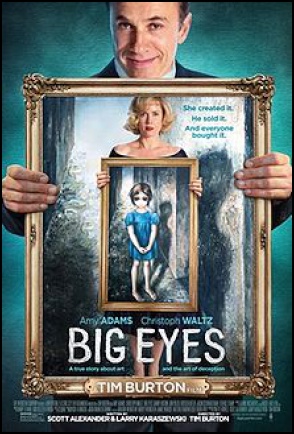Tim Burton Finally Grows up
Howard DavisIt took eleven years from development to completion and now Tim Burton's 'Big Eyes' has finally reached Antipodean screens. It's a heart-warming tale of the artist Margaret Keane's personal odyssey from dependency to empowerment. That she happened to become a hugely successful commercial artist in the process raises all kinds of interesting questions about the nature of art, anticipated both by the Frankfurt School theorist Walter Benjamin's 'The Work of Art in the Age of Mechanical Reproduction' and Susan Sontag's famous essay on kitsch. Like Norman Rockwell before her, Keane was undoubtedly a gifted, talented, and undeniably popular painter. But her obsession with blank-eyed waifs studiously avoided any attempt to master perspective, let alone grapple with the abstract and conceptual transformations that were convulsing modern art at the time. And, again like Rockwell, her work exudes a sentimental schmaltz that's saccharine in the extreme.
Nevertheless, Keane's work is collected by museums around the world and her painting "Our Children" is in the UN permanent collection of art. Hollywood celebrities like Joan Crawford, Natalie Wood and Jerry Lewis all commissioned Keane to paint their portraits. Even President Kennedy asked her to paint John and Carolyn. However, 'Tomorrow Forever,' the UNICEF painting that Keane created for the 1964 Worlds Fair, was never actually mounted. Robert Moses, who had control over everything that was included in the fair, hated it. Once the NY Times art critic John Canady trashed it after seeing a photograph, Moses had it thrown into the garbage.

The movie opens with an adulatory Andy Warhol epigram - "I think what Keane has done is just terrific. It has to be good. If it were bad, so many people wouldn't like it." And when Margaret is seen shopping in a supermarket, just before realizing that her work is being reproduced on posters and postcards everywhere, she selects a can of Campbell's soup (the subject of one of Warhol's most famous paintings). Equally ironically, Woody Allen's 1973 comedy 'Sleeper' envisages a future in which Keane is considered one of the greatest artists in history.
It's interesting to note that the amount of sales of Keane's work soared prior to the film's release, with even small paintings going for over $8,500. Burton himself owns an extensive collection and has commissioned her to paint portraits of his erstwhile girl-friend Lisa Marie, his ex-partner Helena Bonham Carter, and his chihuahua. When Margaret and Walter paint in front of the San Francisco Palace of Fine Arts, the real Margaret Keane can be seen reading a book on the park bench behind them. It's easy to imagine her chuckling up her sleeve throughout the shoot.
Burton does excellent work with authentic period detail, from costumes and decor to antique cars. Both he and cinematographer Bruno Delbonnel initially wanted to shoot on 35mm film, but due to budget restrictions and Vancouver's Deluxe lab closing in 2012, they had to shoot digitally. Nonetheless, the richly colour-saturated palette they manage to achieve beautifully evokes the bohemian beatnik atmosphere of San Francisco in the 1950s. 'The Hungry i' jazz club, one of North Beach's most influential nightspots, is lovingly recreated, as is the Keane's lushly-lit LA home, fully decked out with some wonderful mid-century modern furniture.
Looking uncannily like an early avatar of Cindy Sherman, Amy Adams (fresh from 'American Hustle') plays Margaret Keane with an aching sense of self-restraint. Her performance won her a second Golden Globe award for Best Actress in a Leading Role. She's sequentially seduced, dominated, and abused by her villainous husband Walter, played by Christoph Waltz, who does yet another stellar turn as a philandering, alcoholic, and controlling sociopath with a genius for both self-publicity and self-delusion. From his first appearance (sockless as in 'Spectre,' but flaunting a matelot shirt and rolled-up jeans this time around) we know he's up to no good. Sparkling cameos by Danny Huston, Jason Schwartzman, Jon Polito and Terence Stamp round out a strong supporting cast.
After 'Ed Wood' in 1994, this is Tim Burton's second biopic written by Scott Alexander and Larry Karaszewski. Their narrative trajectory follows the traditional comforting Hollywood arc of growth and redemption. It may not be one of his best pictures, but at least it deals with adult themes and addresses some serious issues. Perhaps Burton has finally grown up.



 Binoy Kampmark: Fallibility, Dirty Wars And Pope Francis I
Binoy Kampmark: Fallibility, Dirty Wars And Pope Francis I Peter Dunne: Dunne's Weekly - An Issue No-one Can Afford To Lose
Peter Dunne: Dunne's Weekly - An Issue No-one Can Afford To Lose Martin LeFevre - Meditations: Choosing Mass Murder?
Martin LeFevre - Meditations: Choosing Mass Murder? Eugene Doyle: Quiet Mutiny - The U.S. Army Falls Apart
Eugene Doyle: Quiet Mutiny - The U.S. Army Falls Apart Gordon Campbell: Papal Picks, And India As A Defence Ally
Gordon Campbell: Papal Picks, And India As A Defence Ally Binoy Kampmark: The Selling Of America - Ending The US Dollar’s Exorbitant Privilege
Binoy Kampmark: The Selling Of America - Ending The US Dollar’s Exorbitant Privilege